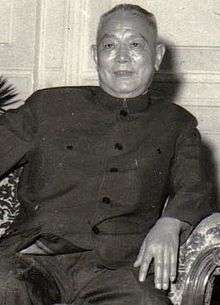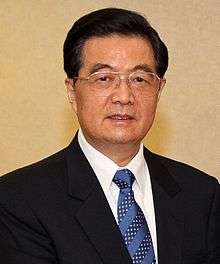List of Presidents of the People's Republic of China
- To avoid confusion, all the names on this list follow the Eastern order convention (family name first, personal name second) for consistency.
This is a list of the Presidents and other heads of state of the People's Republic of China.
The office, called 国家主席 (Guójiā Zhǔxí) in Chinese, was created in 1954 when the 1st Constitution consolidated the system of government in the People's Republic of China. At the time, the title was translated into English as State Chairman. The position was abolished between 1975 and 1982 with the functions of head of state being performed by the Chairman of the Standing Committee of the National People's Congress. The presidency was revived under the fourth constitution in 1982.
List
First Administration Second Administration Third Administration Hu–Wen Administration Xi–Li Administration
Central People's Government (1949–1954)
- Chairman of the Central People's Government
| Portrait | Name (Lifespan) |
Term of office | Vice Chairmen | Paramount leader | |||
|---|---|---|---|---|---|---|---|
| – |  |
Mao Zedong 毛泽东 (1893–1976) |
1 October 1949 | 27 September 1954 | Zhu De Liu Shaoqi Soong Ching-ling Li Jishen Zhang Lan Gao Gang |
Himself | |
The 1st Constitution (1954–1975)
- Chairman of the People's Republic of China
| Portrait | Name (Lifespan) Constituency |
Term of office | NPC | Vice Chairmen | Paramount leader | |||
|---|---|---|---|---|---|---|---|---|
| 1 |  |
Mao Zedong 毛泽东 (1893–1976) Beijing At-large |
27 September 1954 | 27 April 1959 | I | Zhu De | Mao Zedong | |
| 2 |  |
Liu Shaoqi 刘少奇 (1898–1969) Beijing At-large |
27 April 1959 | 3 January 1965 | II | Soong Ching-ling Dong Biwu | ||
| 2 January 1965[1] | 31 October 1968[2] | III | ||||||
| – | Dong Biwu 董必武 (1886–1975) Hubei At-large |
24 February 1972 | 17 January 1975 | III | Vacancy by ascension | |||
The 2nd and 3rd Constitution (1975–1982)
- Chairman of the Standing Committee of the National People's Congress
| Portrait | Name (Lifespan) Constituency |
Term of office | NPC | Vice Chairmen | Paramount leader | |||
|---|---|---|---|---|---|---|---|---|
| – |  |
Zhu De 朱德 (1886–1976) Sichuan At-large |
17 January 1975 | 6 July 1976 | IV | Soong Ching-ling[3] Dong Biwu[3] (died 2 April 1975) and others |
Mao Zedong | |
| – |  |
Soong Ching-ling 宋庆龄 (1893–1981) Shanghai At-large |
6 July 1976 | 5 March 1978 | IV | Hua Guofeng | ||
| After Zhu De's death, Soong Ching-ling served as acting Chairwoman of the Standing Committee of the National People's Congress for the remainder of the 4th National People's Congress's term.She is a member of Revolutionary Committee of the Kuomintang. | ||||||||
| – |  |
Ye Jianying 叶剑英 (1897–1986) PLA |
5 March 1978 | 18 June 1983 | V | Soong Ching-ling and others |
Deng Xiaoping | |
- Honorary Chairwoman of the People's Republic of China
| Portrait | Name (Birth–Death) Constituency |
Term of office | NPC | Notes | ||
|---|---|---|---|---|---|---|
| – |  |
Soong Ching-ling 宋庆龄 (1893–1981) Shanghai At-large |
16 May 1981 | 28 May 1981 | V | Shortly before her death, Soong Ching-ling,a member of Revolutionary Committee of the Kuomintang was named Honorary Chairwoman of the People's Republic of China. |
The 4th Constitution (1983–present)
- President of the People's Republic of China
| Portrait | Name (Lifespan) Constituency |
Term of office | NPC - (Election) | Vice President | Paramount leader | ||
|---|---|---|---|---|---|---|---|
| 3 |  |
Li Xiannian 李先念 (1909–1992) Hubei At-large |
18 June 1983 | 8 April 1988 | VI - (62.5%) | Ulanhu | Deng Xiaoping |
| He started reforms in foreign policy and China began opening to the world. He was first Chinese president who visited USA. He was also the first state president who officially visited North Korea. In 1984, Li met with US President Ronald Reagan during Reagan's visit to China, notably discussing the status of Taiwan with the President. In 1988, Li resigned from his position as President of the People's Republic of China and was replaced by Yang Shangkun. Li was then named Chairman of the National Committee of the CPPCC.[4] | |||||||
| 4 |  |
Yang Shangkun 杨尚昆 (1907–1998) PLA |
9 April 1988 | 27 March 1993 | VII - (66.8%) | Wang Zhen | Deng Xiaoping |
| Yang promoted economic reform but opposed political liberalization, a position which Deng Xiaoping eventually came to identify with. Yang reached the height of his political career after the Tiananmen Square protests of 1989, but his organized opposition to Jiang Zemin's leadership led Deng to force Yang to retire. | |||||||
| 5 |  |
Jiang Zemin 江泽民 (born 1926) Shanghai At-large |
27 March 1993 | 15 March 1998 | VIII - (68.4%) | Rong Yiren | Himself |
| 15 March 1998 | 15 March 2003 | IX - (71.5%) | Hu Jintao | Himself | |||
| Under his leadership, China experienced substantial developmental growth with reforms, saw the peaceful return of Hong Kong from the United Kingdom and Macau from Portugal, and improved its relations with the outside world while the Communist Party maintained its tight control over the government. Jiang has been criticized for being too concerned about his personal image at home, and too conciliatory towards Russia and the United States abroad.[5] Served as Mayor of Shanghai (1985–1989), Chairman of the Central Military Commission of China (1990–2005) | |||||||
| 6 |  |
Hu Jintao 胡锦涛 (born 1942) Tibet At-large (until 2008) Jiangsu At-large (from 2008) |
15 March 2003 | 15 March 2008 | X - (72.9%) | Zeng Qinghong | Himself |
| 15 March 2008 | 14 March 2013 | XI - (70.27%) | Xi Jinping | Himself | |||
| During his term in office, Hu reintroduced state control in some sectors of the economy that were relaxed by the previous administration, and has been conservative with political reforms.[6] Along with his colleague, Premier Wen Jiabao, Hu presided over nearly a decade of consistent economic growth and development that cemented China as a major world power. He sought to improve socio-economic equality domestically through the Scientific Development Concept, which aimed to build a "Socialist Harmonious Society" that was prosperous and free of social conflict.[7] In foreign policy, Hu advocated for "China's peaceful development", pursuing soft power in international relations and a business-oriented approach to diplomacy. Through Hu's tenure, China's influence in Africa, Latin America, and other developing countries has increased.[8] Served as Vice President (1998–2003) | |||||||
| 7 | .jpg) |
Xi Jinping 习近平 (born 1953) Shanghai At-large |
14 March 2013 | Incumbent | XII - (72.21%) | Li Yuanchao | Himself |
| Served as Vice President (2008–2013). | |||||||
Living Former Presidents
As of December 2016, there are two living former presidents:
| President | Term of office | Date of birth |
|---|---|---|
| Jiang Zemin | 1993–2003 | August 17, 1926 |
| Hu Jintao | 2003–2013 | December 21, 1942 |
See also
- Vice President of the People's Republic of China
- List of premiers of the People's Republic of China
- List of vice premiers of the People's Republic of China
- Paramount leader - a informal list of the those who have been considered the highest leader of the party and the People's Republic of China
References
- ↑ "National People's Congress Notice 1". People's Daily. 3 January 1965. Retrieved 2013-11-24.
- ↑ "Communique of the expanded 12th plenary session of the Eighth Central Committee of the Communist Party of China". People's Daily Online. 3 January 1965. Retrieved 2013-11-24.
- 1 2 Sheng Yonghua [盛永華] (2006). Chronological Biography of Soong Ching-ling, 1893-1981 [宋慶齡年譜 1893-1981], in Chinese. Guangzhou: Guangdong People's Publishing [廣東人民出版社]. pp. 2:1799. ISBN 7218052649.
- ↑ Anderson, Kurt (7 May 1984). "History Beckons Again". Time. Retrieved 19 August 2011.
- ↑ Tomoyuki Kojima. China's Omnidirectional Diplomacy: Cooperation with all, Emphasis on Major Powers. Asia-Pacific Review, 1469–2937, Volume 8, Issue 2, 2001
- ↑ Luard, Tim (11 January 2005). "BBC:China's Leader shows his stripes. 11 January 2005". BBC News. Retrieved 13 March 2010.
- ↑ "Kuhn, Robert Lawrence: Hu's Political Philosophies" (PDF). Esnips.com. Retrieved 13 March 2010.
- ↑ World Savvy Monitor: China and the World - A foreign policy overview